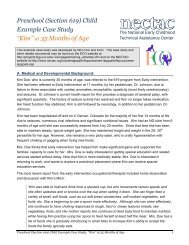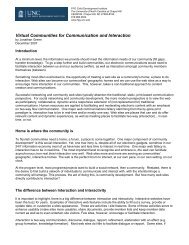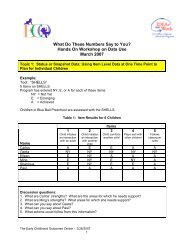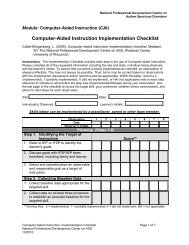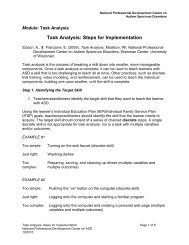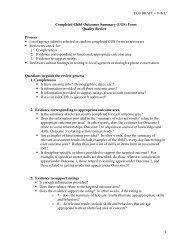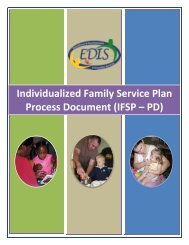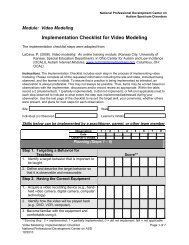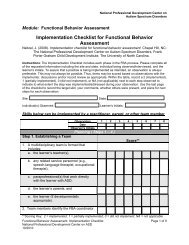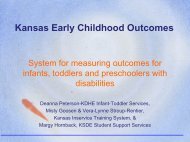The Carolina Curriculum for Infants and Toddlers with Special ...
The Carolina Curriculum for Infants and Toddlers with Special ...
The Carolina Curriculum for Infants and Toddlers with Special ...
You also want an ePaper? Increase the reach of your titles
YUMPU automatically turns print PDFs into web optimized ePapers that Google loves.
CCITSN Crosswalk - 7-26-09<br />
Publisher<br />
Website <strong>for</strong> in<strong>for</strong>mation<br />
Cost<br />
Age range<br />
Purpose<br />
Summary In<strong>for</strong>mation: <strong>The</strong> <strong>Carolina</strong> <strong>Curriculum</strong> <strong>for</strong> <strong>Infants</strong> <strong>and</strong> <strong>Toddlers</strong> <strong>with</strong> <strong>Special</strong> Needs,<br />
Third Edition (CCITSN; 2004)<br />
Brookes Publishing<br />
www.brookespublishing.com<br />
$48.95 <strong>for</strong> <strong>Curriculum</strong>; $25.00 <strong>for</strong> package of 10 assessment logs that include the developmental<br />
progress chart; $75.00 <strong>for</strong> downloadable printable masters of assessment logs; $139.95 <strong>for</strong> master<br />
<strong>for</strong>ms on CD (CD includes infant/ toddler <strong>and</strong> preschool <strong>for</strong>ms).<br />
Birth – 36 months<br />
Areas included • Personal-Social<br />
• Cognition<br />
• Communication<br />
• Fine Motor<br />
• Gross Motor<br />
Time to administer<br />
Scored<br />
Age norms<br />
Age ranges given <strong>for</strong> items<br />
How frequently it can be given<br />
St<strong>and</strong>ardized tasks<br />
Based on observation in natural<br />
settings<br />
“<strong>The</strong> CCITSN is a systematic curriculum that directly links a skills assessment <strong>with</strong> activities to promote<br />
those skills that have not been mastered.”<br />
60-90 minutes. It can be split into two or more sessions<br />
Yes. Approximate age-based levels of development in each domain are suggested based on the<br />
pattern of credit received on items in the curriculum sequence in the developmental progress chart<br />
No<br />
Yes. Age levels are “estimates based on in<strong>for</strong>mation from st<strong>and</strong>ardized instruments <strong>and</strong> the literature<br />
on infant <strong>and</strong> toddler development.”<br />
Flexible<br />
No. Assessment guidelines include general assessment procedures to elicit each skill if it is not<br />
observed during the in<strong>for</strong>mal observation period at the beginning of the assessment<br />
Yes. In<strong>for</strong>mal observation <strong>and</strong> directed assessment<br />
Note: This is a preliminary draft developed by the Early Childhood Outcomes Center. We are still in the process of refining <strong>and</strong> revising this document which<br />
means that some of the categorizations could change based on additional discussion. We welcome your feedback to .<br />
1
CCITSN Crosswalk - 7-26-09<br />
Summary In<strong>for</strong>mation (continued): <strong>The</strong> <strong>Carolina</strong> <strong>Curriculum</strong> <strong>for</strong> <strong>Infants</strong> <strong>and</strong> <strong>Toddlers</strong> <strong>with</strong> <strong>Special</strong> Needs,<br />
Third Edition (CCITSN; 2004)<br />
Instructions related to parent role<br />
Data provided on reliability<br />
Data provided on validity<br />
Web-based data entry<br />
Electronic scoring<br />
Other languages<br />
Who administers<br />
Training available through the<br />
publisher<br />
Parent in<strong>for</strong>mally interacts <strong>with</strong> the child during the observation period. When directed assessment is<br />
needed, the parent can be instructed to try particular activities <strong>with</strong> the child at the assessor‟s<br />
discretion. Parents are asked about the child‟s skills when observation <strong>and</strong> directed assessment does<br />
not elicit behaviors from the child<br />
Not available<br />
Not available<br />
Not available<br />
Not available<br />
Assessment log <strong>and</strong> developmental progress chart available in Spanish<br />
Not specified. “People <strong>with</strong> minimal experience <strong>and</strong> education in child development can underst<strong>and</strong> <strong>and</strong><br />
follow the instructions <strong>for</strong> assessing the skill each item represents <strong>and</strong> <strong>for</strong> engaging in activities to<br />
promote the development of that skill”<br />
Yes. See http://www.brookespublishing.com/onlocation/topics/carolina.htm<br />
Note: This is a preliminary draft developed by the Early Childhood Outcomes Center. We are still in the process of refining <strong>and</strong> revising this document which<br />
means that some of the categorizations could change based on additional discussion. We welcome your feedback to .<br />
2
CCITSN Crosswalk - 7-26-09<br />
<strong>The</strong> <strong>Carolina</strong> <strong>Curriculum</strong> <strong>for</strong> <strong>Infants</strong> <strong>and</strong> <strong>Toddlers</strong> <strong>with</strong> <strong>Special</strong> Needs, Third Edition (CCITSN):<br />
Crosswalk to Child Outcomes<br />
Outcome 1:<br />
Has positive social relationships<br />
Outcome 2:<br />
Acquires <strong>and</strong> uses skills <strong>and</strong> knowledge<br />
Outcome 3:<br />
Takes appropriate action to meet needs<br />
Personal-Social<br />
2. Interpersonal Skills<br />
a-bb. Smiles reciprocally, participates in simple<br />
games, approaches peer or adult to initiate<br />
play, works collaboratively toward a goal <strong>with</strong><br />
peers, etc.<br />
3. Self-Concept<br />
a-t. Responds to name, plays <strong>with</strong> mirror<br />
image, expresses feelings (4 or more types),<br />
“per<strong>for</strong>ms” <strong>for</strong> others, shows pride in<br />
achievements, shows guilt or shame over<br />
accidents or prohibited behavior, etc.<br />
Communication<br />
14. Conversation Skills<br />
a-ll. Smiles to person who is talking <strong>and</strong>/or<br />
gesturing, laughs, waits <strong>for</strong> adult to take a turn,<br />
plays reciprocal games, greets familiar people<br />
<strong>with</strong> an appropriate vocalization or sign,<br />
sustains conversation, etc.<br />
Personal-Social<br />
3. Self-Concept<br />
a-t. Recognizes self <strong>and</strong> others in mirror,<br />
identifies objects as “mine”, distinguishes <strong>and</strong><br />
names self in photographs, knows age, tells<br />
own first name, answers correctly when asked<br />
if he or she is a boy or a girl, etc.<br />
Cognition<br />
5. Attention & Memory: Visual/Spatial<br />
a-h. Visually fixates <strong>for</strong> at least 3 seconds,<br />
shows anticipation of regularly occurring<br />
events in everyday care, retrieves object fully<br />
hidden under a cover, reacts to a change in<br />
familiar game, retrieves objects from usual<br />
locations on request, recognizes the covers of<br />
several books <strong>and</strong> labels them, tells the name<br />
of an object or picture shown briefly <strong>and</strong> shown<br />
again in an array of four, etc.<br />
6-II. Visual Perception: Matching & Sorting<br />
a-d. Sorts by size, matches primary colors,<br />
sorts by shape, sorts by two characteristics,<br />
etc.<br />
Personal-Social<br />
1. Self-Regulation & Responsibility<br />
a-o. Com<strong>for</strong>ts self, entertains self <strong>with</strong> toys <strong>for</strong><br />
a short period of time, gets toys to play <strong>with</strong><br />
from a box or shelf of toys, explores, avoids<br />
common dangers, etc.<br />
3. Self-Concept<br />
a-t. Makes choices, says “no” or otherwise<br />
indicates refusal, resists attempts from others<br />
to assist <strong>with</strong> feedings, identifies objects as<br />
“mine”, competes <strong>with</strong> peers <strong>for</strong> toys, asks <strong>for</strong><br />
snacks or drinks, shows determination/<br />
persistence in choosing or continuing activities,<br />
is selective about what tasks he or she will or<br />
will not try (recognizes limitations), etc.<br />
4-I. Self-Help: Eating<br />
a-z. Smoothly sucks from a nipple, holds own<br />
bottle, feeds self <strong>with</strong> fingers, holds <strong>and</strong> drinks<br />
from a cup, begins to use <strong>for</strong>k, etc.<br />
4-II. Self-Help: Dressing<br />
a-l. Cooperates in dressing <strong>and</strong> undressing,<br />
unties shoes, removes shoes, removes coat,<br />
undoes fasteners, etc.<br />
Note: This is a preliminary draft developed by the Early Childhood Outcomes Center. We are still in the process of refining <strong>and</strong> revising this document which<br />
means that some of the categorizations could change based on additional discussion. We welcome your feedback to .<br />
3
CCITSN Crosswalk - 7-26-09<br />
Outcome 1:<br />
Has positive social relationships<br />
Outcome 2:<br />
Acquires <strong>and</strong> uses skills <strong>and</strong> knowledge<br />
Cognition<br />
7. Functional Use of Objects & Symbolic<br />
Play<br />
a-r. Explores objects <strong>with</strong> mouth, combines<br />
two objects in a functional manner, pretends<br />
that objects are something other than what<br />
they are, assumes different roles in fantasy<br />
play, etc.<br />
8. Problem Solving/Reasoning<br />
a-aa. Shifts attention, repeats activities that<br />
produce interesting results, looks <strong>for</strong> or<br />
reaches toward objects falling from view,<br />
plays <strong>with</strong> a variety of toys to produce effects,<br />
reaches object from behind barrier, solves<br />
simple problems <strong>with</strong>out adult assistance,<br />
nests containers of graduated sizes,<br />
experiments <strong>with</strong> cause <strong>and</strong> effect when<br />
playing, answers at least one „why do‟ question<br />
correctly, etc.<br />
9. Number Concepts<br />
a-f. Underst<strong>and</strong>s „more,‟ correctly answers<br />
„how many‟ <strong>for</strong> one <strong>and</strong> two objects<br />
Cognition/Communication<br />
10. Concepts/Vocabulary: Receptive<br />
a-v. Points to three objects or people on<br />
request, follows directions, selects pictures of<br />
actions, points to five or more colors on<br />
request, selects objects by usage, etc.<br />
Outcome 3:<br />
Takes appropriate action to meet needs<br />
Personal-Social<br />
4-III. Self-Help: Grooming<br />
a-j. Cooperates in washing <strong>and</strong> drying h<strong>and</strong>s,<br />
wipes nose, washes self <strong>with</strong> washcloth, etc.<br />
4-IV. Self-Help: Toileting<br />
a-g. Indicates need <strong>for</strong> soiled diaper or pants<br />
to be changed, urinates when placed on toilet,<br />
uses toilet by self, etc.<br />
Communication<br />
14. Conversation Skills<br />
a-ll. Provides consistent signals <strong>for</strong> states of<br />
hunger, distress, <strong>and</strong> pleasure, makes<br />
requests by directing caregiver‟s attention,<br />
changes pitch/volume to signify intensity of<br />
desires, uses words or signs to express wants<br />
or request actions, says “yes” <strong>and</strong> “no” to<br />
indicate desires or preferences, requests<br />
assistance, etc.<br />
Fine Motor<br />
18. Grasp & Manipulation*<br />
a-bb. Actively moves arm after seeing or<br />
hearing an object, bats at object, manipulates<br />
objects <strong>with</strong> h<strong>and</strong>s <strong>and</strong> fingers, uses index<br />
finger to poke, turns pages one at a time, turns<br />
doorknob, puts small object through small hole<br />
in container, etc.<br />
Note: This is a preliminary draft developed by the Early Childhood Outcomes Center. We are still in the process of refining <strong>and</strong> revising this document which<br />
means that some of the categorizations could change based on additional discussion. We welcome your feedback to .<br />
4
CCITSN Crosswalk - 7-26-09<br />
Outcome 1:<br />
Has positive social relationships<br />
Outcome 2:<br />
Acquires <strong>and</strong> uses skills <strong>and</strong> knowledge<br />
Cognition/Communication<br />
11. Concepts/Vocabulary: Expressive<br />
a-r. Vocalizes repetitive consonant-vowel<br />
combinations, labels two or more pictures,<br />
uses at least 50 different words, repeats new<br />
words to self, etc.<br />
12. Attention & Memory: Auditory<br />
a-u. Quiets when presented <strong>with</strong> noise, turns<br />
hear or reaches toward sound, shows<br />
recognition of a few familiar sounds, matches<br />
objects to their sounds, anticipates parts of<br />
rhymes or songs, identifies objects, people,<br />
<strong>and</strong> events by their sounds, independently<br />
says or acts out parts of rhymes or songs, etc.<br />
13. Verbal Comprehension<br />
a-o. Turns to the direction from which name is<br />
being called, responds <strong>with</strong> correct gestures to<br />
„up‟ <strong>and</strong> „bye-bye,‟ responds to „give me,‟<br />
follows simple comm<strong>and</strong>s, follows two-part<br />
comm<strong>and</strong>s, etc.<br />
15. Grammatical Structure<br />
a-k. Uses inflection patterns in a sentence,<br />
uses auxiliary verbs, usually shortened<br />
(„gonna,‟ „wanna‟), uses negative terms,<br />
personal pronouns, etc.<br />
16. Imitation: Vocal<br />
a-q. Repeats sounds, imitates inflection<br />
imitates familiar words, repeats sentences, etc.<br />
Outcome 3:<br />
Takes appropriate action to meet needs<br />
Fine Motor<br />
19. Bilateral Skills*<br />
a-u. Raises both h<strong>and</strong>s when object is<br />
presented, brings h<strong>and</strong>s together at midline,<br />
plays <strong>with</strong> own feet or toes, unscrews small<br />
lids, unbuttons large buttons, etc.<br />
20. Tool Use<br />
a-j. Pulls string to obtain object or make effect,<br />
uses stick to obtain object, holds bowl <strong>and</strong><br />
stirs, spreads <strong>with</strong> knife, etc.<br />
21. Visual-Motor Skills<br />
a-j. Marks paper <strong>with</strong> writing implement,<br />
imitates vertical stroke, pretends to write,<br />
copies a circle, snips <strong>with</strong> scissors, etc.<br />
Gross Motor<br />
22-I. Upright: Posture & Locomotion*<br />
a-h. Holds head steady when held, takes<br />
independent steps, walks sideways, jumps on<br />
floor, walks backward 10 feet, walks on all<br />
types of surfaces <strong>with</strong>out falling, runs, walks up<br />
stairs, avoids obstacles when running, etc.<br />
Gross Motor<br />
23. Prone (on Stomach)*<br />
a-p. Lifts head freeing nose (arms <strong>and</strong> legs<br />
flexed), rolls from stomach to back, pulls self to<br />
h<strong>and</strong>s <strong>and</strong> knees, creeps up stairs, etc.<br />
24. Supine (on Back)*<br />
a-g. Bends <strong>and</strong> straightens arms <strong>and</strong> legs,<br />
brings h<strong>and</strong>s to mouth, holds feet in air <strong>for</strong><br />
Note: This is a preliminary draft developed by the Early Childhood Outcomes Center. We are still in the process of refining <strong>and</strong> revising this document which<br />
means that some of the categorizations could change based on additional discussion. We welcome your feedback to .<br />
5
CCITSN Crosswalk - 7-26-09<br />
Outcome 1:<br />
Has positive social relationships<br />
Outcome 2:<br />
Acquires <strong>and</strong> uses skills <strong>and</strong> knowledge<br />
Fine Motor<br />
17. Imitation: Motor*<br />
a-n. Continues movement if imitated by<br />
caregiver, imitates unfamiliar movements,<br />
imitates actions related to the function of<br />
objects, imitates actions after several hour<br />
delay, imitates a sequence of two unrelated<br />
motor acts, etc.<br />
21. Visual-Motor Skills<br />
a-j. Marks paper <strong>with</strong> writing implement,<br />
imitates vertical stroke, pretends to write,<br />
copies a circle, etc.<br />
Outcome 3:<br />
Takes appropriate action to meet needs<br />
play, rolls from back to stomach, etc.<br />
*Precursor skills <strong>for</strong> functional behaviors. <strong>The</strong>se skills may not be appropriate or expected <strong>for</strong> some children <strong>with</strong> motor impairments.<br />
Note: Areas that are not precursor to or specific components of any of the three outcomes, <strong>and</strong> there<strong>for</strong>e not included in the crosswalk, were:<br />
Cognition<br />
6-I. Visual Perception: Blocks & Puzzles<br />
a-n. Places large round <strong>for</strong>m in <strong>for</strong>m board, completes simple puzzles, imitates block building, etc.<br />
Gross Motor<br />
22-II. Upright: Balance<br />
a-j. St<strong>and</strong>s on one foot, rises onto tiptoes, walks three steps on balance beam, etc.<br />
22-III. Upright: Ball Play<br />
a-i. Rolls ball, kicks ball, throws ball to adult 5-9 feet away, etc.<br />
22-IV. Upright: Outdoor Play<br />
a-i. Explores play area <strong>with</strong> supervision, enjoys swinging <strong>and</strong> sliding, uses slide independently, climbs slanted/vertical ladders, climbs on low jungle gym<br />
bars <strong>and</strong> will drop several inches to the ground, etc.<br />
Note: This is a preliminary draft developed by the Early Childhood Outcomes Center. We are still in the process of refining <strong>and</strong> revising this document which<br />
means that some of the categorizations could change based on additional discussion. We welcome your feedback to .<br />
6



